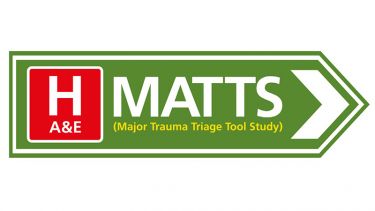Project overview
MATTS validation and service evaluation: The diagnostic accuracy and real-life performance of major trauma triage tools.
Background
The MATTS project is a comprehensive programme of research investigating pre-hospital triage tools for use in NHS major trauma networks.
Its aim is to develop an accurate, acceptable and usable pre-hospital triage tool to identify patients with major trauma benefiting from MTC care.
The project consists of 3 phases:
- Phase one: Identification and review of existing triage tools, and development of a new tool by expert consensus, for evaluation in subsequent phases.
- Phase two: A prospective cohort study to validate triage tools from Phase One and identify an optimally performing candidate triage tool.
- Phase three: Operational implementation and service evaluation of the candidate triage tool.
Design
- a) Phase one - Triage tool identification and development
-
- A series of sub-studies will identify existing triage tools; and develop a new tool for further evaluation, comprising:
- A systematic review and document analysis of current tools
- A retrospective cohort study and focus groups with clinicians to identify predictors of major trauma. Decision analytical modelling evaluating trade-offs between under/over-triage
- Expert consensus and PPI process to define which patients should receive MTC care and develop a new major trauma triage tool
- b) Phase two - validation study
-
A prospective cohort study to validate and compare the diagnostic accuracy of paramedic judgement, existing, and consensus derived major trauma triage tools:
- Setting: Major trauma networks within the West Midlands, Yorkshire, South Western and London Ambulance Services
- Study population: Any patient attended by EMS following injury. Sub-group analyses of children (<16 years) and elderly patients (≥65 years)
- Index tests: Existing and expert consensus-derived major trauma triage tools scored according to observed pre-hospital variables
- Reference standard: Patients with the potential to benefit from MTC care previously defined by independent expert consensus (clinicians, stakeholders) and Patient and Public Involvement (PPI) consultation. Secondary reference standards of Injury Severity Score (ISS) >15 and mortality/morbidity risk range defined from preceding decision analytical modelling
- Outcomes: Under/over-triage rates
- Data collection: Linkage of triage tool variables, reference standard and outcomes using prospective EMS and augmented TARN data
- Sample size: The estimated prevalence of major trauma is 0.8% amongst all EMS calls for injury. The four collaborating ambulance services estimate 300,000 EMS calls for injury per 6 months. Assuming, based on ASCOT criteria, a triage tool requires sensitivity of 95% and specificity of 70% (equivalent to under- and over-triage rates of 5% and 30% respectively), then a sample of 100,000 injured patients (<4 months’ of data collection in participating trauma networks) would provide a 95% confidence interval (CI) of ±2.0% for triage sensitivity and the under-triage rate; and a 95% CI of ±0.3% for triage specificity and the over-triage rate
- Outputs: Optimally performing candidate triage tool identified by expert consensus, PPI and participating trauma networks
- c) Phase three - Evaluation of system-level performance of implemented optimal triage tool
-
A service evaluation characterising under/over-triage rates of the candidate triage tool when implemented operationally:
- Setting: Major trauma network within each of the West Midlands, Yorkshire, South Western and London Ambulance Services
- Study population: Any patient attended by EMS following injury. Sub-group analyses of children (<16 years) and elderly patients (≥65 years)
- Outcomes: Under/over-triage rates based on actual patient destinations and observed hospital pre-alerts
- Data collection: Linkage of pre-hospital and hospital variables using prospective EMS and augmented TARN data
- Sample size: The estimated prevalence of major trauma is 0.8% amongst all EMS calls for injury. The four collaborating ambulance services estimate 300,000 EMS calls for injury per 6 months. Assuming, based on ASCOT criteria, a triage tool requires sensitivity of 95% and specificity of 70% (equivalent to under- and over-triage rates of 5% and 30% respectively), then a sample of 57,125 injured patients (<4 months’ of data collection in participating trauma networks) would provide a 95% confidence interval (CI) of ±2.0% for triage sensitivity and the under-triage rate; and a 95% CI of <1% for triage specificity and the over-triage rate
- Evaluation of acceptability and usability to patients, ambulance services, and other important stakeholders using mixed-methods
- Cost-effectiveness of alternative triage tools using decision analytical modelling
Project timetable
A 31-month funded 3-phase research programme:
- Phase 1 Development work: Permissions and set up, systematic review, retrospective cohort study, clinician focus groups, decision analytical modelling, and expert consensus process (10 months). Conducted prior to the Phase 2 validation and Phase 3 implementation studies primarily considered in the current protocol
- Phase 2 Validation study: Prospective data collection, linkage and analysis (8 months)
- Phase 3 Service evaluation: Triage tool implementation, mixed methods assessment of performance, acceptability and usability (7 months)
- Close-out: Cost-effectiveness modelling, analysis and write-up (6 months)
Expertise
A highly experienced team with a track record of successfully delivering challenging pre-hospital studies.
Specialists in pre-hospital care, major trauma, health services research, data management and linkage, systematic reviews, statistics, health economics, and strong PPI input.
An expert advisory group of methodologists, and key policy, ambulance service and clinical stakeholders.
Funding and sponsorship
This project is funded by the National Institute for Health Research Health Technology Assessment Programme (reference 17/16/04). The views and opinions expressed therein are those of the authors and do not necessarily reflect those of the Health Technology Assessment Programme, NIHR, NHS or the Department of Health.
The project is sponsored by The University of Sheffield.
For further details regarding MATTS, please contact:
Tia Callaghan
Clinical Trials Research Unit
School of Health and Related Research
Regent Court
30 Regent Street
Sheffield
SD1 4DA
+44 114 222 4397

Major Trauma Triage Study
The MATTS project is a comprehensive programme of research investigating pre-hospital triage tools for use in NHS major trauma networks.
